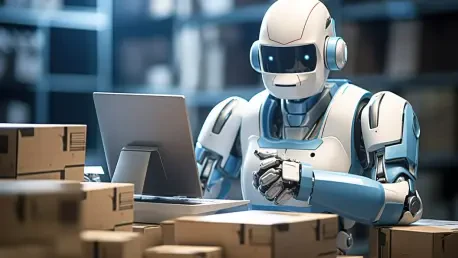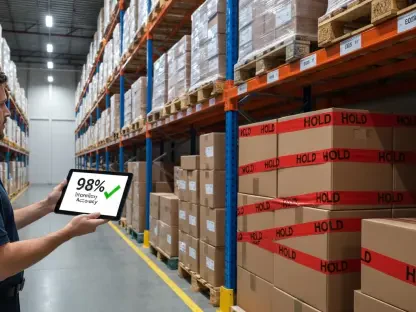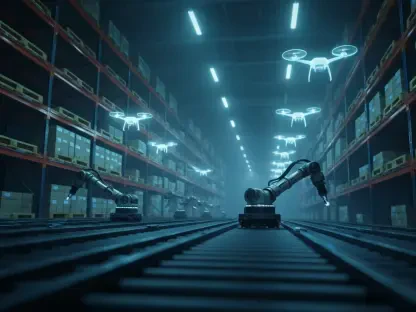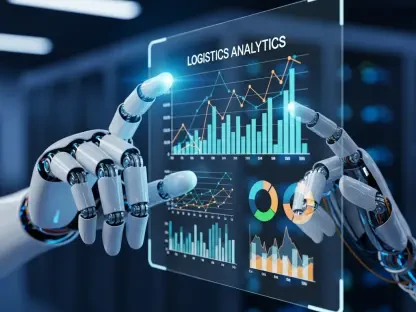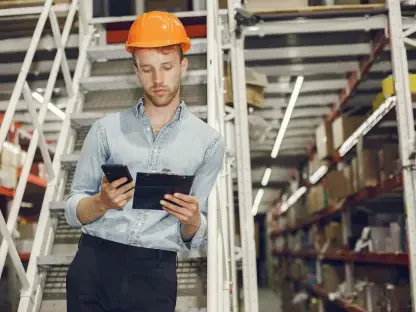In the fast-paced world of e-commerce, where same-day delivery has become a benchmark for customer satisfaction, Amazon stands at the forefront of innovation by deploying over one million robots across its global fulfillment network, underscoring a seismic shift in logistics. The company leverages artificial intelligence to redefine warehouse efficiency. The integration of AI-powered robotics not only accelerates order processing but also raises critical questions about the future of human labor and operational scalability in an industry under constant pressure to deliver faster and cheaper.
The Landscape of Warehouse Automation Today
Warehouse automation has emerged as a cornerstone of the logistics sector, driven by the relentless demand for speed and precision in e-commerce. With global online retail sales soaring, companies are racing to streamline operations, reduce costs, and meet consumer expectations. Automation technologies, including robotics and AI, have become essential tools in managing vast inventories and ensuring timely deliveries, transforming traditional warehouses into high-tech hubs of efficiency.
Amazon leads this transformation with its massive robotic fleet, setting a benchmark for the industry. The company’s pioneering efforts have positioned it as a dominant player among competitors like Walmart and Alibaba, who are also investing heavily in automation. The convergence of AI, machine learning, and advanced robotics has enabled unprecedented levels of operational efficiency, allowing Amazon to handle peak demand periods with agility and maintain its edge in a highly competitive market.
The significance of efficiency cannot be overstated in an era where customer loyalty hinges on rapid delivery. As e-commerce continues to grow, the pressure to optimize every aspect of the supply chain intensifies. Amazon’s strategic focus on automation reflects a broader industry trend toward integrating cutting-edge technology to address logistical challenges, paving the way for smarter, more responsive warehouse systems.
AI-Driven Innovation in Amazon’s Warehouses
Key Technological Advancements and Trends
The evolution of warehouse automation is being shaped by remarkable advancements in AI, with capabilities such as computer vision, machine learning, and path optimization at the core of these developments. These technologies empower robots to identify products with precision, navigate complex environments, and adapt to dynamic workflows. Amazon’s latest robots, including Proteus, an autonomous mobile unit, and Vulcan, a robotic arm with advanced vision systems, exemplify how AI enhances operational fluidity by handling intricate tasks like delicate item processing.
Consumer demand for faster delivery continues to fuel innovation in this space. As expectations shift toward near-instant gratification, companies are compelled to scale operations rapidly. AI-driven robots offer a solution by automating repetitive tasks, freeing up resources for strategic growth. The scalability potential is immense, with systems like DeepFleet optimizing travel routes to ensure robots move efficiently through crowded warehouse floors, directly addressing the need for speed.
These trends highlight a broader movement toward intelligent automation in logistics. The ability of robots to predict maintenance needs through sensor data further minimizes downtime, ensuring seamless operations. As Amazon continues to refine these technologies, the ripple effect across the industry encourages other players to adopt similar innovations, setting new standards for what warehouses can achieve.
Performance Metrics and Growth Projections
The measurable impact of AI-powered robotics on Amazon’s operations is striking. Facilities equipped with these advanced systems report a notable reduction in order processing times, with some achieving up to a 10 percent decrease in robot travel time due to optimized routing algorithms. This efficiency translates into significant cost savings, as shorter cycle times and smarter inventory placement reduce operational overheads at a massive scale.
Looking ahead, the adoption of AI in logistics is projected to accelerate between now and 2027, with analysts anticipating that over 60 percent of major warehouse operators will integrate such systems. For Amazon, this trend points to potential market dominance, as early investments in robotics position the company to capitalize on growing demand for automated solutions. The financial benefits, coupled with enhanced customer satisfaction through faster deliveries, solidify its competitive advantage.
Beyond immediate gains, the long-term outlook suggests a transformation in how warehouses function. Data from current deployments indicates that even small improvements in efficiency can yield substantial returns for a company of Amazon’s size. As technology matures, the industry expects further breakthroughs in robot autonomy and integration, promising even greater productivity in the years to come.
Challenges in Implementing AI-Powered Robotics
The deployment of AI-powered robots, while revolutionary, comes with a host of challenges that cannot be overlooked. High installation and maintenance costs present significant barriers, particularly for smaller players unable to match Amazon’s investment capacity. These financial hurdles could widen the gap between industry giants and emerging competitors, reshaping the competitive landscape in favor of those with deeper pockets.
Beyond economics, the specter of job displacement looms large. As automation takes over repetitive tasks, concerns about reduced hours and layoffs persist among labor groups. Amazon has responded with upskilling programs to transition workers into technical roles, but the scale of change raises questions about the long-term viability of traditional warehouse jobs. Balancing technological progress with workforce stability remains a pressing issue for the sector.
Safety in human-robot shared spaces is another critical concern. Ensuring that autonomous machines operate without posing risks to employees requires robust protocols and constant vigilance. While Amazon has implemented strict safety measures, critics argue that the true intelligence of AI systems is often overstated, necessitating careful scrutiny. Addressing these multifaceted challenges demands a commitment to innovation as well as responsibility, a balance the industry continues to navigate.
Regulatory and Ethical Considerations in Warehouse Automation
The integration of AI and robotics in warehouses operates within a complex regulatory framework that spans labor laws, workplace safety standards, and data privacy issues. Governments worldwide are increasingly scrutinizing automation’s impact on employment, pushing for policies that protect workers from displacement while fostering technological advancement. Compliance with these evolving regulations is essential for companies like Amazon to avoid legal and reputational risks.
Ethical implications also weigh heavily on the discourse surrounding warehouse automation. The reduction of human roles in favor of machines prompts debates about fairness and the social value of work. Amazon has made efforts to maintain transparency in its automation practices, publicly detailing safety initiatives and training programs. However, the broader industry must grapple with the moral responsibility of ensuring that technology serves to augment rather than replace human contributions.
Data privacy emerges as another pivotal concern, given the vast amounts of information processed by AI systems. Protecting sensitive operational and employee data from breaches is paramount, as regulatory bodies tighten oversight on digital security. The path forward requires a delicate balance of innovation and accountability, with transparency serving as a cornerstone for building trust among stakeholders in this rapidly evolving field.
The Future of Smart Warehouses with AI and Robotics
Envisioning the trajectory of warehouse automation reveals a future dominated by even more sophisticated AI systems. Agentic AI, capable of independent decision-making, is on the horizon, promising to elevate robot autonomy to new heights. Coupled with advancements in tactile sensing and multi-arm coordination, these developments could redefine precision and adaptability in handling diverse inventory types, further streamlining operations.
Sustainability also stands to benefit from these innovations. Optimized robot travel and energy-efficient systems are expected to reduce warehouse carbon footprints, aligning with global environmental goals. As economic and technological trends evolve through 2030, the integration of cloud services and data analytics will likely create interconnected warehouse ecosystems, enhancing responsiveness to market fluctuations and consumer demands.
Human roles in this future landscape are set to transform significantly. While manual tasks diminish, opportunities in oversight, systems engineering, and problem-solving are projected to grow. The challenge lies in preparing the workforce for this shift, ensuring that technological progress does not outpace societal readiness. The smart warehouse of tomorrow will likely be a hub of collaboration between humans and machines, driven by a shared goal of efficiency and innovation.
Conclusion: Balancing Efficiency and Responsibility
Reflecting on the strides made in warehouse automation, it is evident that Amazon’s adoption of AI-powered robots marks a turning point for logistics, enhancing efficiency while reshaping the interplay between technology and human labor. The journey illuminates both the transformative potential of these systems and the hurdles that accompany their implementation. Operational gains stand alongside concerns over job security and safety, painting a nuanced picture of progress.
Moving forward, the industry must prioritize actionable strategies to address these challenges. Investing in comprehensive training programs emerges as a critical step to equip workers for emerging roles in a tech-driven environment. Simultaneously, fostering transparency in automation practices becomes essential to maintain trust among employees and regulators alike. By focusing on these initiatives, stakeholders can ensure that the benefits of AI and robotics are harnessed responsibly, paving the way for a future where efficiency and equity go hand in hand.
